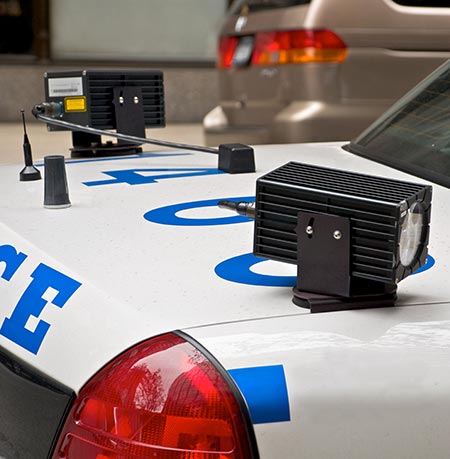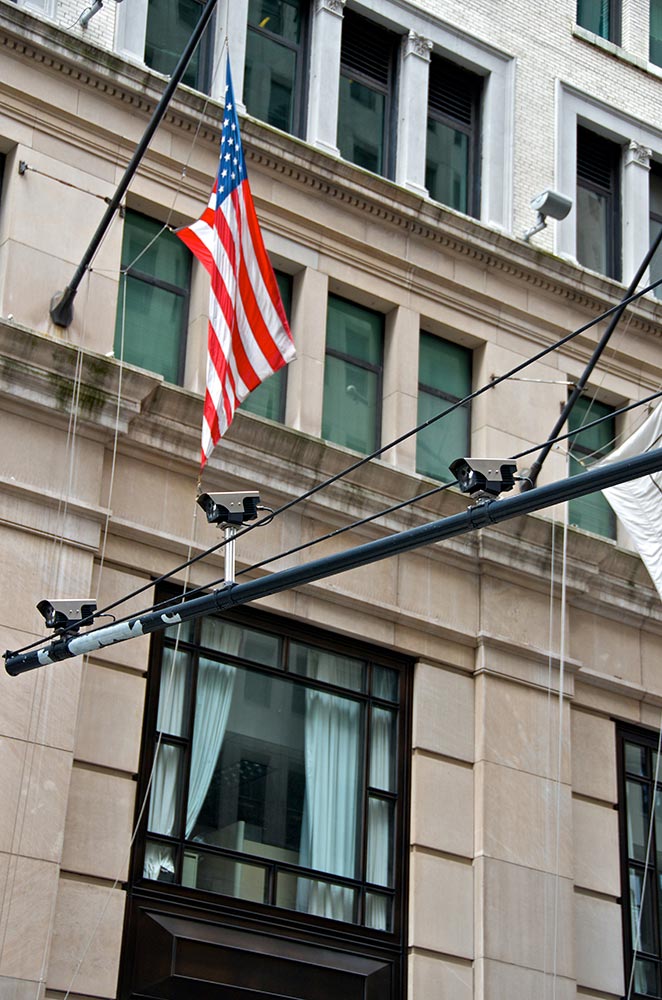Contact Us
To provide feedback on the Community Policing Dispatch, e-mail the editorial board at CPDispatch@usdoj.gov.
To obtain details on COPS Office programs, publications, and resources, contact the COPS Office Response Center at 800-421-6770 or AskCopsRC@usdoj.gov

U.S. Department of Justice
Office of Community Oriented Policing Services
Washington, DC 20530
In an effort to foster and promote trust between law enforcement and the communities they are sworn to protect and serve, agencies have committed themselves to community policing. Community policing efforts involve several different strategies such as townhall meetings, neighborhood watch programs, crime prevention meetings, police/youth activities, volunteer programs, vacation house checks, etc.
As concerns regarding “quality of life” crimes increase, law enforcement agencies have been improving their community policing efforts by using technology and innovation to protect communities and apprehend perpetrators. Many agencies have invested in spreading their message through various social media platforms, while others, like the Marietta (Georgia) Police Department have created an online database where residents and businesses can register their surveillance camera systems with the department. If a crime occurs in the area, the department can quickly query a map to determine if surveillance cameras exist that may have captured the incident, instead of sending an officer to each location to check for footage. Others, such as the Arcadia (California) Police Department have purchased specialized Electronic Stake Out GPS tracking devices to deploy in items such as bikes and parcel packages that are being stolen in neighborhoods. The Redlands (California) Police Department (RPD) used the same GPS technology to create the award-winning While You’re Away Program. Residents who will be away from their homes for an extended amount of time can complete an online application, pick up a laptop computer containing an ESO GPS tracking device, and self-deploy it at their residences.
 In addition, agencies have been using automated license plate readers (LPR) on major ingress/egress points to capture vehicles entering and exiting. Unfortunately, the costs associated with traditional LPR programs have prevented law enforcement agencies from deploying the technology in residential communities as a strategy to protect residents and businesses. It can cost over tens of thousands of dollars to install LPR cameras in all four directions at some intersections. Residents have also been hesitant on embracing the technology due to LPR vendors storing the captured license plate data for several years in their databases. Police departments, such as Redlands, have long wanted to implement an LPR strategy in neighborhoods to address crime, but have struggled to fund such a program and gain the support of people living in the area. But with camera technology becoming more affordable, companies have emerged that are focused on providing an LPR strategy more suited to the concerns of residents and businesses.
In addition, agencies have been using automated license plate readers (LPR) on major ingress/egress points to capture vehicles entering and exiting. Unfortunately, the costs associated with traditional LPR programs have prevented law enforcement agencies from deploying the technology in residential communities as a strategy to protect residents and businesses. It can cost over tens of thousands of dollars to install LPR cameras in all four directions at some intersections. Residents have also been hesitant on embracing the technology due to LPR vendors storing the captured license plate data for several years in their databases. Police departments, such as Redlands, have long wanted to implement an LPR strategy in neighborhoods to address crime, but have struggled to fund such a program and gain the support of people living in the area. But with camera technology becoming more affordable, companies have emerged that are focused on providing an LPR strategy more suited to the concerns of residents and businesses.
For example, the jurisdiction of the Memorial Villages Police Department, located just outside of Houston, Texas, has been prone to property crime—almost entirely committed, according to Police Chief Ray Schultz, by people living outside the jurisdiction. Knowing that the suspects were traveling to his community by vehicle, Chief Schultz convinced the leaders of Memorial Villages to invest in 18 LPR camera systems manufactured by Flock Safety, Inc. for a small fraction of what it would cost to purchase, install, and maintain other LPR systems that he researched. These cameras were installed at the major ingress/egress points of the jurisdiction.
During the initial implementation phase, two residential burglaries took place within minutes of each other, only a block apart. One of the suspects had inadvertently left behind a receipt for four cheeseburgers from a nearby McDonalds inside one of the burglarized homes. Detectives determined a neighbor’s video surveillance system captured possible suspects arriving at the victim’s house in a white sedan that also had a unique sunroof. Armed with this information, detectives went to the nearby McDonalds, 15 minutes away from the LPR camera. Using the receipt and the time of the sale, they were able to see the suspects who had purchased the cheeseburgers were in a small grey sedan. Not yet knowing that two different vehicles might be involved, the detectives then went to the LPR database. Using the time just prior to the burglaries, detectives first searched for small grey sedans. And while there were a total of 58 grey sedans that had passed though the LPR, only one passed through twice, both outbound towards McDonalds and back towards the location of the burglaries a short time later. A second search for the white sedan showed over 500 vehicles matching that description had passed by the LPR; however, only one had the unique sunroof, and that vehicle was directly behind the grey sedan on the LPR cameras.
The LPR did its job; it was able to provide detectives with the license plate numbers of both vehicles. Detectives were able track down the suspects tied to each vehicle. One vehicle was owned by a construction worker who had been working nearby where the burglaries occurred and had likely observed the victims leave their homes, allowing the suspect to coordinate the burglaries with accomplices in the white sedan. Being able to use LPR technology to develop leads allowed these cases to be linked together and solved. The value of having LPR cameras in a neighborhood was certainly demonstrated by this one event.
 To foster police legitimacy and public trust, it is essential to give residents and business owners confidence that if they ever are victim to a crime, police will hold the perpetrators accountable. To aid in this, the RPD decided to install the same type of LPR camera. They chose Flock Safety because it was inconspicuous, therefore not an eyesore to the community; powered by solar so it could be installed in locations that do not have access to power; contained fast processing speeds to capture vehicles traveling at high rates of speed; accessible via the web or phone based app to provide easy search capabilities for officers in the field; activated via motion so that those vehicles displaying paper plates are caught on camera; and, most importantly, affordable so as not to stress the limited financial resources of the department.
To foster police legitimacy and public trust, it is essential to give residents and business owners confidence that if they ever are victim to a crime, police will hold the perpetrators accountable. To aid in this, the RPD decided to install the same type of LPR camera. They chose Flock Safety because it was inconspicuous, therefore not an eyesore to the community; powered by solar so it could be installed in locations that do not have access to power; contained fast processing speeds to capture vehicles traveling at high rates of speed; accessible via the web or phone based app to provide easy search capabilities for officers in the field; activated via motion so that those vehicles displaying paper plates are caught on camera; and, most importantly, affordable so as not to stress the limited financial resources of the department.
Recognizing that there may be some people in the community who may have reservations about police capturing license plate data in their neighborhoods, the RPD first had the Redlands Privacy Council, which is made up of concerned citizens, vet the program and sign off on it. They then followed the Police Foundation’s advice for how to approach the community when implementing a drone program and held a community meeting to explain the program in detail and allow citizens to voice concerns and ask questions. The meeting was livestreamed and residents were able to comment and ask questions about the program via social media. Finally, the RPD distributed a press release to the local newspaper. Transparency is extremely important to the RPD leadership and they wanted to use all avenues available to inform residents and business owners of the strategy.
The information dissemination helped ease most people’s concerns, as the positive comments posted on social media easily outnumbered the negative. For the concerns that were brought up, the RPD was able to address them and gain even more support. For example, the fact that all data is only to be retained for 30 days helped alleviate those concerns that the data would be kept for years and possibly used for other purposes. After learning the benefits of this technology, several community members even pooled their financial resources to fund nine cameras, thereby enhancing a police/community partnership and allowing the RPD to cover all major egress routes to the predominantly residential south side portion of the city. If suspects are coming to the area to commit crime, they will likely be captured on one of the cameras when they leave.
The RPD’s investment has quickly paid off. In less than five months, the cameras have been responsible for capturing the suspects’ getaway vehicles in several felonious crimes including nighttime commercial restaurant burglaries, an armed robbery at a gas station, residential burglaries, a street robbery and aggravated assault, the theft of numerous propane tanks, and a serial mail theft. When detectives arrested a suspect in one of the restaurant burglaries, they quickly tied him to two other restaurant burglaries in the area. In another incident, a victim saw a grey BMW pull up to her mailbox. A passenger exited the vehicle and stole the contents of the mailbox. An LPR camera caught the vehicle and its license plate as it left the area. Detectives were able to flag the license plate in the system, and when the vehicle returned a week later, police received an alert allowing for authorities to stop the vehicle. They found that the vehicle contained three suspects and mail from numerous different houses. Postal inspectors had been investigating the three suspects and federal indictments are forthcoming.
As law enforcement continue to devote resources toward community policing, it is evident the use of LPR technology can be a valuable addition to their tool belt. Residents and business owners appreciate an opportunity to partner with their police in helping apprehend those responsible for victimizing their communities. The technology has evolved; in the past, LPR cameras only caught images of metal license plates. Now, the technology exists to capture vehicles that are displaying paper plates. Memorial Villages recently recovered a stolen vehicle from a customized license plate alert. By adopting an LPR strategy specifically designed for neighborhoods, law enforcement agencies can continue to show their commitment to providing a high level of service to those who they are sworn to protect and serve.
Travis Martinez is the Assistant Chief of Police for the Redlands Police Department and has over 25 years of experience as a law enforcement officer. He can be reached at tmartinez@redlandspolice.org.
Subscribe to Email Updates
To sign up for monthly updates or to access your subscriber preferences, please enter your email address in the Subscribe box.






